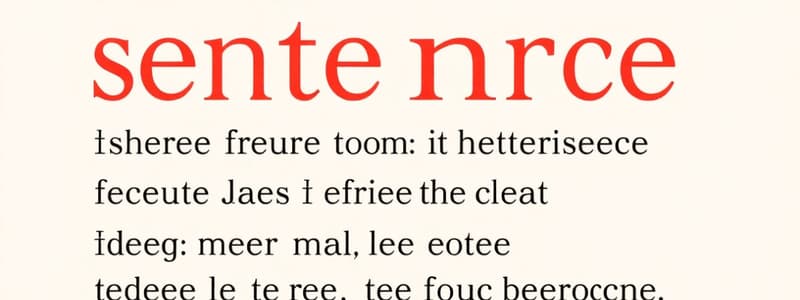Podcast
Questions and Answers
What is the role of the direct object in a sentence?
What is the role of the direct object in a sentence?
It receives the action done by the subject.
How is a basic sentence constructed?
How is a basic sentence constructed?
Subject + Verb + Who or What
What does the indirect object tell us in a sentence?
What does the indirect object tell us in a sentence?
Whom or for whom the action of the verb is done.
What is the function of the subject in a sentence?
What is the function of the subject in a sentence?
What type of verb requires both a subject and a direct object?
What type of verb requires both a subject and a direct object?
What is a predicate in the context of a sentence?
What is a predicate in the context of a sentence?
In a sentence with a linking verb, what does the subject complement do?
In a sentence with a linking verb, what does the subject complement do?
Which sentence structure indicates a transitive verb?
Which sentence structure indicates a transitive verb?
What is the definition of a predicate nominative?
What is the definition of a predicate nominative?
Flashcards are hidden until you start studying
Study Notes
Parts of Speech
- Content Words: Include nouns, verbs, adverbs, adjectives, and interjections.
- Function Words: Comprised of pronouns, auxiliary verbs, prepositions, determiners, and conjunctions.
Direct Object
- Receives the action performed by the subject (answers "who" or "what").
- In sentences, it is a noun or noun phrase receiving the action of the verb.
- Basic structure: Subject + Verb + Direct Object (e.g., "Her secret admirer gave her a bouquet of flowers").
Indirect Object
- Precedes the direct object and indicates to whom or for whom the action is done.
- Structure: Subject + Verb + Direct Object + Indirect Object (e.g., "Her secret admirer gave her a bouquet of flowers").
Elements of a Sentence
- Subject: The doer of the action; can be a noun or pronoun and answers what the sentence is about.
- Predicate: Part of the sentence that expresses what is said about the subject; usually includes the verb and may have objects or modifiers.
Basic Sentence Patterns
- Definition of a sentence: A group of words expressing meaning, composed of a subject and predicate.
- Subject–Intransitive Verb (S-IV): Intransitive verbs have no direct object (e.g., "The old woman laughs," "She cried," "People work," "He slept," "The students ran").
Subject-Transitive Structures
- Subject–Transitive Verb–Direct Object (S-TV-DO): Requires a direct object (e.g., "He called the cashier beautiful," "The class elected Nadine president," "The students helped the barangay").
Object Complement
- Follows a direct object and renames or describes it (e.g., "He called the cashier beautiful").
Indirect Object Definition
- Indicates who or for whom the action is done; comes before the direct object in a sentence (e.g., "Someone ate my sandwich," "I played the piano," "The boards showed their approval").
Subject-Linked Structures
- Subject–Linking Verb–Subject Complement (S-LV-PN): Predicate nominative completes a linking verb and renames the subject.
Listening Skills
- Involves receiving, constructing meaning from, and responding to a spoken or non-verbal message.
- Recognizes and comprehends the meaning conveyed by speakers, akin to the role of teachers as nurturers and guides.
Studying That Suits You
Use AI to generate personalized quizzes and flashcards to suit your learning preferences.




